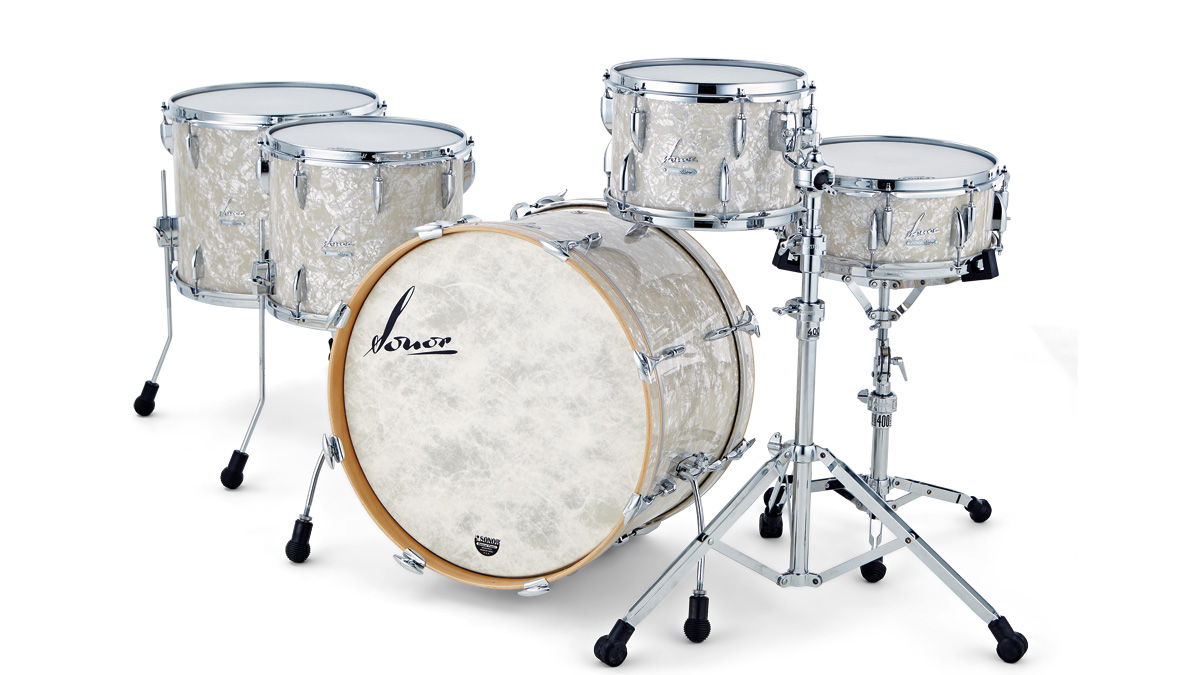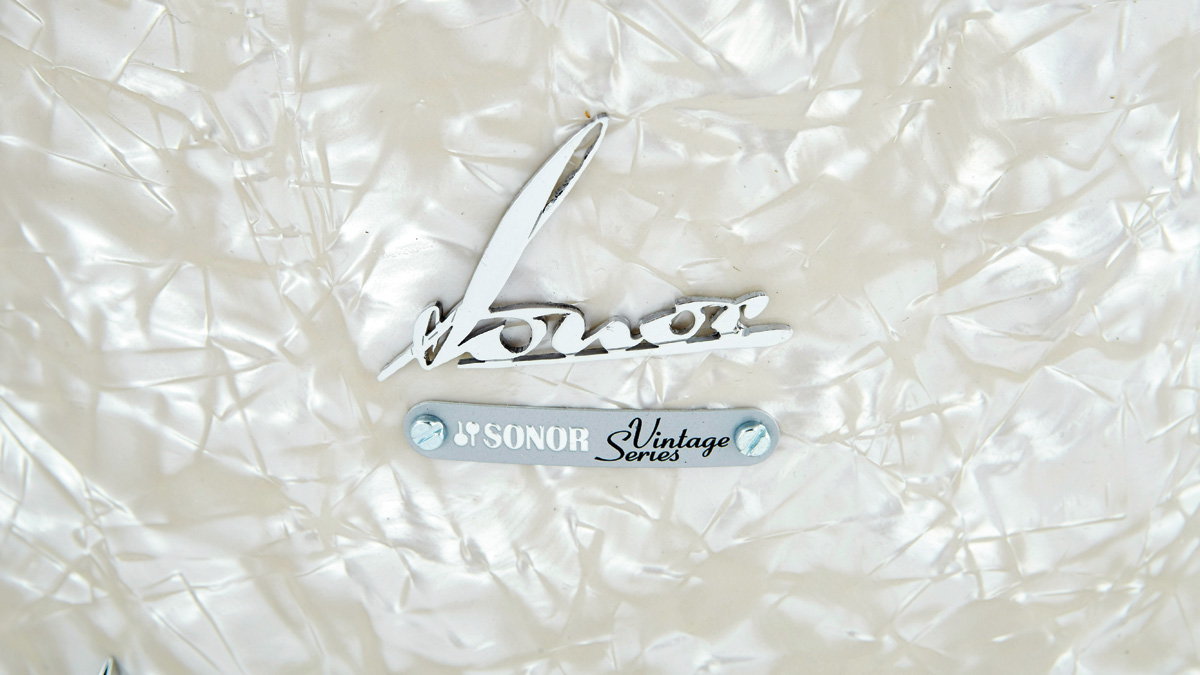MusicRadar Verdict
With its beech shells, rounded bearing edges, Superprofil hoops and teardrop lugs, Sonor's Vintage Series recalls a fondly- remembered defining period in the German company's 140-year evolution.
Pros
- +
A beautiful blast from the past.
Cons
- -
More finish options would be welcome.
MusicRadar's got your back

Sonor Vintage Series

Sonor Vintage Series

Sonor Vintage Series
As the drum world forges ahead with new innovations there is a definite parallel movement towards resurrecting some of the better aspects of vintage styles. Gretsch and Ludwig have done it and now it is Sonor's turn.
Sonor was founded in 1875, which makes 2015 its 140th anniversary, older than Gretsch and Ludwig (both, by the way, started by German émigrés to the USA). In the UK of the 1960s, Trixon was more visible, but Sonor was already quietly making top quality 'teardrop' lug kits.
So elongated were these lugs that they had to be offset on the shallower snares and toms, creating a chic image which Sonor has recreated in its new Vintage Series.
Build
The aim is to recapture the vibe of that period from the 1950s when Sonor modernised, up till the mid-1970s when the more familiar, heavy-duty Sonor kicked in. The '50s was a time of massive change in the drum world and Sonor, as with UK and US drums, was evolving fast. Crucial features were the beech shells and the imaginative hardware and fittings.
Let's start with those shells. Hand-selected premium German beech wood is layered in nine plies, 6mm thick, constructed using Sonor's cross-laminated tension free (CLTF) system. Instead of today's 45° bearing edges the Vintage series returns to the increasingly popular rounded bearing edges, the summit of which is lovely and smooth. Inside the shells display the warm reddish tint of the beech and Sonor trademark vertical inner ply.
Sonor is marketing two set-ups, the Three20 and the Three22. You can buy drums separately though, with a choice of 12 vintage sizes. The extended review set-up is 22"x14", 13"x8", 14"x12", 16"x14" with 14"x53⁄4" snare.
In terms of finish, there are just three options - the Vintage Pearl wrap of the review kit and two semi-gloss stains in Vintage Onyx and Vintage Natural. You may prefer the stains (which are slightly cheaper) to the yellowish aged pearl. Sonor had many cool finishes in the 1960-'70s - it would be great to see a few more of those in the future. How about it, Sonor?
Sonor has resurrected its stylish 1950s script logo badge, as used between 1952 and 1961. Underneath though is placed a small banner declaring 'Sonor Vintage Series'. This seems unnecessary and rather detracts from the great look of the script badge.
Also revamped are the 2.3mm triple-flanged steel hoops. These are stamped with 'SONOR Vintage Superprofil' and the top lip is bent over and in rather than out - another nod towards the 1950s. They are particularly weighty and together with the long lugs and dense beech shells make the drums heavier than average.
"Sonor had many cool finishes in the 1960-'70s - it would be great to see a few more of those in the future. How about it, Sonor?"
Other things have undergone inevitable updates. Old Sonor drums, like other European drums, had screwdriver- friendly slot-headed tension screws. The Vintage series has bowed to modern technology and has drum key-tightened TuneSafe tension bolts with fine-pitch threads.
Bass drums are undrilled, but have classic chunky cast 'T' rods for tensioning, and fold-out curvaceous spurs, all adding to the smart and refined look. Small toms have a simple small bracket for a hexagonal mounting rod. It's unobtrusive and much firmer than the brackets of the 1950/'60s.
There are two matching wood-shelled snare drums - a 14"x61⁄2" and a slightly unusually proportioned 14"x53⁄4". The other interesting feature is the new snare throw-off. The 'Super 50' is a rare design, based on a 1950s Sonor, and as you expect from Sonor it's a prettily made bit of kit.
The strainer lever is reminiscent of vintage 'baseball bat' style muffler levers, and unusually the minimal mechanism is secreted within the shell. There's a firm and secure feel to the lever, while the small tension knob for the Sonor 24-strand German-made stainless steel wires is positioned at the butt end.
Hands On
Those rounded bearing edges undoubtedly soften the attack and darken the sound, increasing the beechy woody timbre, while shortening the decay a fraction. This tightening effect is added to by the heavy rims which seem to enclose and compact the sound a little more with a hint of the effect that Gretsch's heavy die-cast rims have.
Sonor generally ships with Remo heads, but the review kit came with Evans Coated 360s on the toms and snare. Either way, white coated single-ply heads, top and bottom, add to the vintage sound and look. With the 360s, and considering all the above sonic components together, the toms have a tone which is more on the calf side than the sharp attacking sound of 45° edges.
The 13"x8" tom is a vintage Sonor size, one inch shallower than the usual 13"x9", and with a little more clout and speed as a result. We found it refreshing after the ubiquitous 13"x9" which can be over-boomy. Likewise, the 14"x12" and 16"x14" floor toms benefit from being shallower (ie: not the more traditional 1960s square sizes), which does make them that bit more compressed and distinct - less lumbering.
"The 13"x8" tom is a vintage Sonor size, one inch shallower than the usual 13"x9", and with a little more clout and speed as a result."
The bass drum came with a Fibreskyn front head and Evans 360 Coated batter. With no port hole, and tuned quite firmly, the sound was commandingly strong, clean and quite hard. Very '60s, especially given the 14" depth and rounded edges. Traditionally tuned with the batter wrinkles just out, there was plenty of beef.
With such a woody set it makes sense to have a matching wood snare. Tonally it accords better than a more clattery metal. Again the Superprofil hoops and rounded edges tighten the centre beat - there's a feeling of being compacted and focused. But catch the comfortable-feeling rims and they certainly ring out abundantly.
Beech is an underused wood and yet one which is always greeted with enthusiasm when it crops up. It's been described as having the clarity of birch with some of the warmth and resonance of maple. That's a decent enough description.
Now we wouldn't normally suggest this, but there is a video of Steve Smith testing the Vintage kit (with 20" bass and 12" tom), and to our ears the drums sound close to perfection. There's probably no need to say more! Search out 'Sonor Vintage Series: Steve Smith Performance' on YouTube.
In fact, Sonor has done us a service here because it's followed by another video of Smith playing his more familiar modern Sonor fusion kit with CS heads and the difference is blisteringly clear. The latter might work better for much of Steve's electro-fusion stuff, but the Vintage is warmer and more rounded, bluffer and tubbier - great for any classic jazz or rock with its authentically evocative '50s/'60s tone.
With its latest free update, Ableton has finally turned Note into the app I always wanted it to be
Technically capable, but struggle to make your tunes sound musical? 5 simple music theory hacks to make your tracks stand out
"Despite its size, it delivers impressive audio quality and premium functions as well as featuring a good selection of inspired sounds": Roland GO:Piano 88PX review









